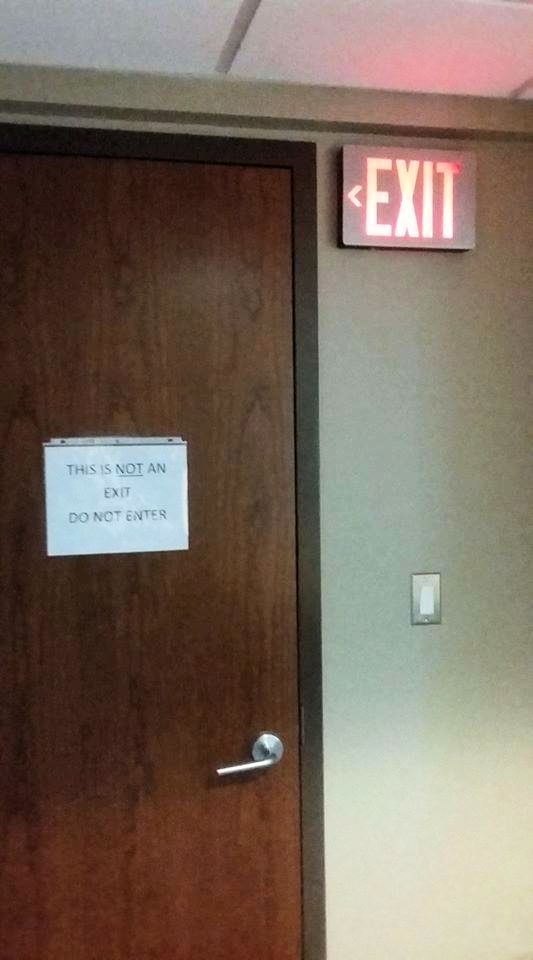 TJ Quintana and David Mentier of DH Pace both sent me this photo of an exit sign in an unfortunate location. I know those of us in the door and hardware industry don’t place exit signs, but I have wondered about the requirements when I’ve seen other situations like this.
TJ Quintana and David Mentier of DH Pace both sent me this photo of an exit sign in an unfortunate location. I know those of us in the door and hardware industry don’t place exit signs, but I have wondered about the requirements when I’ve seen other situations like this.
Here are a few quick tips from the IBC:
- The egress path must have exit signs when the exit or path is not readily visible to building occupants.
- Egress doors within exits must have exit signs.
- The distance from any point in an exit access corridor or exit passageway to an exit sign can not be more than 100 feet (or the listed viewing distance from the sign – whichever is less).
- Required exit signs must be readily visible from any direction.
Sometimes when I ask people if the door they are asking about is a required means of egress, the response will be “No – there is no exit sign.” Lots of required egress doors don’t have exit signs.
Here are some locations that are NOT required by the IBC to have exit signs:
- If a room or area is only required to have one exit or exit access, an exit sign is not required.
- Exit signs may be omitted at main exterior exit doors/gates that are obvious exits, IF approved by the code official.
- Group U occupancies are not required to have exit signs. (If you’re not familiar with Group U or the groups below, click here to study the IBC use groups.)
- Individual dwelling units and sleeping units in Groups R-1, R-2, and R-3 are not require to have exit signs.
- In I-3 occupancies, exit signs are not required in dayrooms, sleeping rooms, or dormitories.
- Vomitories in Groups A-4 and A-5 are not required to have exit signs on the seating side or openings into seating areas, if exit signs on the concourse are readily apparent from the vomitories.
If you see any other poorly-placed exit signs, send me a photo!
You need to login or register to bookmark/favorite this content.





I would guess that this is at the turn in a corridor and people are mistaking the door for the exit when the actual exit is down at the end of corridor These directional exit signs are required by code, albeit to the dismay of the tenant behind that door. A ceiling placed sign may solve some of the problem.
True. Here’s a question you might know the answer to (I don’t)…what happens when you need an exit sign over a door (imagine a cross-corridor pair), but the ceiling height is low enough that the exit sign protrudes down past the 80-inch-AFF point?
– Lori
Hmmmm. Good point. Do they need to market hologram signs?
The NFPA 101 Life Safety Code (2012) contains specific verbiage for signage for doors, passages, and stairs that are NOT an exit but could be mistaken for one :
7.10.8.3* No Exit.
7.10.8.3.1 Any door, passage, or stairway that is neither an exit nor a way of exit access and that is located or arranged so that it is likely to be mistaken for an exit shall be identified by a sign that reads as follows:
NO EXIT
7.10.8.3.2 The NO EXIT sign shall have the word NO in letters 2 in. (51 mm) high, with a stroke width of Ys in. (9.5 mm), and the word EXIT in letters 1 in. (25 mm) high, with the
word EXIT below the word NO, unless such sign is an approved existing sign.
A.7.10.8.3 The likelihood of occupants mistaking passageways or stairways that lead to dead-end spaces for exit doors and becoming trapped governs the need for exit signs. Thus, such areas should be marked with a sign that reads as follows:
NO EXIT
Supplementary identification indicating the character of area, such as TO BASEMENT, STOREROOM, LINEN CLOSET, or the like, is permitted to be provided.
Thanks Todd. Maybe they should change the paper sign. 🙂
– Lori
That’s a great picture of a door with an exit sign and a paper sign that says it’s not an exit and the door being in-swinging.
Inswinging doors can often be egress doors, but an inswinging door wouldn’t usually have an exit sign. But most people don’t stop to think about any of that.
– Lori
I find all of your posts terrific. You consistently improve my knowledge base. Thank you and keep up the great work!
Thanks Les!
– Lori
Exit sign would be an exception to the hieght rule:::
IBC
Ceiling height.
The means of egress shall have a ceiling height of not less than 7 feet 6 inches (2286 mm).
Exceptions:
1. Sloped ceilings in accordance with Section 1208.2.
2. Ceilings of dwelling units and sleeping units within residential occupancies in accordance with Section 1208.2.
3. Allowable projections in accordance with Section 1003.3.
4. Stair headroom in accordance with Section 1011.3.
5. Door height in accordance with Section 1010.1.1.
6. Ramp headroom in accordance with Section 1012.5.2.
7. The clear height of floor levels in vehicular and pedestrian traffic areas of public and private parking garages in accordance with Section 406.4.1.
8. Areas above and below mezzanine floors in accordance with Section 505.2.
1003.3 Protruding objects.
Protruding objects on circulation paths shall comply with the requirements of Sections 1003.3.1 through 1003.3.4.
1003.3.1 Headroom.
Protruding objects are permitted to extend below the minimum ceiling height required by Section 1003.2 where a minimum headroom of 80 inches (2032 mm) is provided over any walking surface, including walks, corridors, aisles and passageways. Not more than 50 percent of the ceiling area of a means of egress shall be reduced in height by protruding objects.
Exception: Door closers and stops shall not reduce headroom to less than 78 inches (1981 mm).
A barrier shall be provided where the vertical clearance is less than 80 inches (2032 mm) high. The leading edge of such a barrier shall be located 27 inches (686 mm) maximum above the floor.
1003.3.2 Post-mounted objects.
A free-standing object mounted on a post or pylon shall not overhang that post or pylon more than 4 inches (102 mm) where the lowest point of the leading edge is more than 27 inches (686 mm) and less than 80 inches (2032 mm) above the walking surface. Where a sign or other obstruction is mounted between posts or pylons and the clear distance between the posts or pylons is greater than 12 inches (305 mm), the lowest edge of such sign or obstruction shall be 27 inches (686 mm) maximum or 80 inches (2032 mm) minimum above the finished floor or ground.
Exception: These requirements shall not apply to sloping portions of handrails between the top and bottom riser of stairs and above the ramp run.
1003.3.3 Horizontal projections.
Objects with leading edges more than 27 inches (685 mm) and not more than 80 inches (2030 mm) above the floor shall not project horizontally more than 4 inches (102 mm) into the circulation path.
Exception: Handrails are permitted to protrude 41/2 inches (114 mm) from the wall.
Thanks Charles –
I’ve read all of that before but I don’t see a specific exception for exit signs. Am I missing it?
– Lori
I thought I have been taught this applies to ceiling exit signs::
Not more than 50 percent of the ceiling area of a means of egress shall be reduced in height by protruding objects.
Commentary really does not help.
Will look at 101 to see if something there
When installing an exit door, it’s important to place the exit signs in the right position. This is an important safety feature, which means that the signs need to be hung properly.
Thanks for explaining that any point in the exit corridors can’t be more than 100 feet from the sign, or must be under the listed viewing distance, whichever is less. My husband and I want to buy a retail building, so I’m trying to learn more about the legal requirements for light-up exit signs. I’m glad I read your article because you gave me an idea of the guidelines we’ll need to follow as we have exit signs installed.
You’re welcome!
– Lori